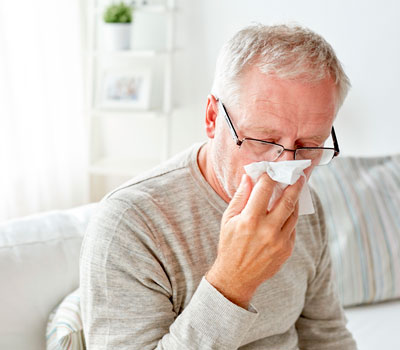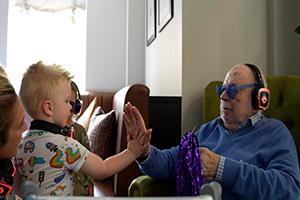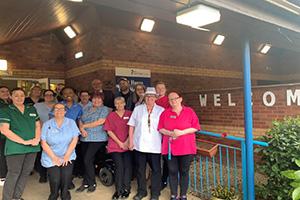Beating the flu in care homes this winter
Influenza (commonly known as the “flu”) season is in full swing. This usually brings a chorus of sniffs and sneezes as people across the UK battle through illness. While flu outbreaks come as no surprise as temperatures drop, it has been reported that cases are at their highest level on record, and that the current rate of flu is worse than at any point last winter.
This year’s flu season has been challenging for the NHS, with reports of outbreaks across several hospitals, and other illnesses such as ‘coronavirus’ putting more pressure on resources. This also comes at a time when A&E waiting times are at their worst since records began in 2004.
With this in mind, contagious flu is of particular concern for care home managers. Footfall in care homes can be high, with a range of visitors, healthcare professionals and other service providers onsite, so keeping the environment clean and sanitised can understandably be a challenge for staff. However, with elderly or infirm residents who may be vulnerable to infection, it is critically important that hygiene standards don’t slip at any point throughout the year.
Care home managers should make sure they have a routine cleaning regime in place and know when a specialist cleaning team should be brought in to deal with cleans outside of the norm. To ensure high hygiene standards this winter, managers should also look to schedule a deep clean of key communal areas such as the residents’ lounge and visitor waiting room, as well as their kitchens and washrooms. This could help protect residents from infection via cross contamination and reduce employee absenteeism as they fight through flu season.
What is ‘flu’?
The flu is a viral infection caused by various strains of influenza viruses. It can be caught at any time of the year, but is more common during  the winter period, partly because we spend more time indoors when it is cold and wet, and therefore viruses can spread more readily.
the winter period, partly because we spend more time indoors when it is cold and wet, and therefore viruses can spread more readily.
Despite many associating the flu with the cold weather, the main source of flu is other people. The flu virus is present in the mouth and nose of people who have the flu. When you cough or sneeze you launch thousands of viral particles such as saliva and mucus into the air – making it easy to pass from person to person in confined spaces such as communal areas.
Perfect personal hygiene
An important part of a care home manager’s job is to encourage employees to take care of their own personal health and hygiene to prevent the spread of illness. With care workers being in close contact with residents every day, it is crucial that staff are fully educated on the best ways to maintain personal hygiene.
One important area that managers should emphasise is hand hygiene. Cross contamination can be a particular problem in communal environments, as some diseases can live on hard surfaces such as door handles and walls, and are transmissible for several days. To minimise the spread of bacteria and viruses, hands should be washed thoroughly for 20–30 seconds using soap and water.
It’s also important that staff dry their hands properly. It has been shown that damp hands spread 1,000 times more bacteria than dry hands, so it is crucial that the drying stage is not overlooked. Staff should also have access to alcohol-free sanitisers, as they provide an effective, long-lasting barrier to protect against microorganisms.
Continuous training and development for both management and staff helps to ensure high standards of hygiene are maintained alongside operational efficiency. This can also help prevent unnecessary downtime in the facility, minimising disruption to the lives of residents.
A clean routine
It’s essential that cleaning is carried out in care homes both proactively and reactively.
Proactive cleaning involves the routine disinfection of shared contact points – such as door handles, surface tops – and communal areas. Reactive cleaning occurs when necessary. In care homes, this often takes place in response to an outbreak of illness, or when an individual presents a transmissible infection. In this case, all areas inhabited by the individual should be thoroughly disinfected.
Regular deep cleans are also important. This involves conducting a thorough clean by moving all furniture away from the walls to make sure no areas are being missed from the cleaning routine. Ideally, deep cleans should be carried out at least twice a year by a professional cleaning company. They will have access to specialist multi-purpose biocidal cleaners which can decontaminate surfaces by killing bacteria, fungi, spores, yeasts and viruses.
Specialist cleaning after an outbreak
While a routine cleaning regime can help to keep infection under control, outbreaks can still occur. An outbreak of a disease, such as influenza, needs to be dealt with as quickly as possible to minimise the risk to residents.
Ultra Low Volume (ULV) disinfectant fogging is a method of disinfection, carried out by a specialist, which enables the treatment of large areas in a short space of time. It works by generating a mist of disinfectant, which settles on top of, underneath and on the sides of objects, soft furnishings, furniture and hard-to-reach areas, offering maximum surface area coverage. Fogging is also fast-drying and can significantly reduce the number of pathogens present when compared to manual surface cleaning alone.
It’s important that employees don’t become complacent following a visit from a professional cleaning company, as another outbreak could occur if standards are not maintained.
Final thoughts
With influenza on the rise, and new strains seemingly arising each year, its important than ever for care home managers to take the time now to make sure there is an effective cleaning regime in place, and that all their employees are adhering to personal hygiene best practice.
Article from:
Paul Casson, Technical Field Manager, Rentokil Specialist Hygiene &
Jamie Woodhall, Area Technical Manager, Initial Washroom Hygiene





